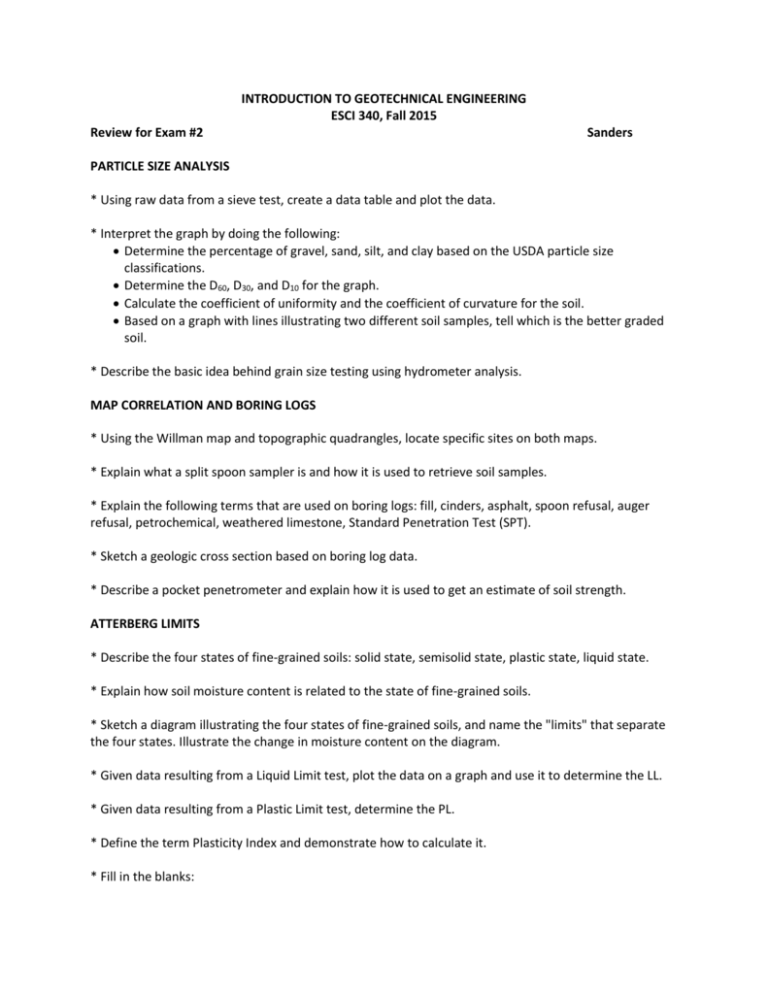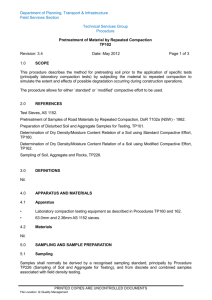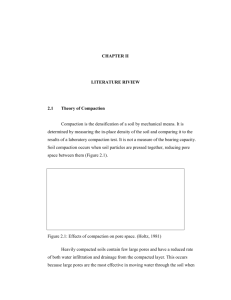See the review sheet here.
advertisement

INTRODUCTION TO GEOTECHNICAL ENGINEERING ESCI 340, Fall 2015 Review for Exam #2 Sanders PARTICLE SIZE ANALYSIS * Using raw data from a sieve test, create a data table and plot the data. * Interpret the graph by doing the following: Determine the percentage of gravel, sand, silt, and clay based on the USDA particle size classifications. Determine the D60, D30, and D10 for the graph. Calculate the coefficient of uniformity and the coefficient of curvature for the soil. Based on a graph with lines illustrating two different soil samples, tell which is the better graded soil. * Describe the basic idea behind grain size testing using hydrometer analysis. MAP CORRELATION AND BORING LOGS * Using the Willman map and topographic quadrangles, locate specific sites on both maps. * Explain what a split spoon sampler is and how it is used to retrieve soil samples. * Explain the following terms that are used on boring logs: fill, cinders, asphalt, spoon refusal, auger refusal, petrochemical, weathered limestone, Standard Penetration Test (SPT). * Sketch a geologic cross section based on boring log data. * Describe a pocket penetrometer and explain how it is used to get an estimate of soil strength. ATTERBERG LIMITS * Describe the four states of fine-grained soils: solid state, semisolid state, plastic state, liquid state. * Explain how soil moisture content is related to the state of fine-grained soils. * Sketch a diagram illustrating the four states of fine-grained soils, and name the "limits" that separate the four states. Illustrate the change in moisture content on the diagram. * Given data resulting from a Liquid Limit test, plot the data on a graph and use it to determine the LL. * Given data resulting from a Plastic Limit test, determine the PL. * Define the term Plasticity Index and demonstrate how to calculate it. * Fill in the blanks: Clay-rich soils are in a plastic state over a wide range of moisture content, and therefore are said to have a high ____. Clay-poor soils are in a plastic state over a narrow range of moisture content, and are said to have a ____ Plasticity Index (PI). SOIL CLASSIFICATION * Describe the USDA classification system. Triangular graph paper can be found here. * Given the results of a grain size distribution test, use the USDA classification system to classify the soil. * Given the results of grain size distribution and Atterberg Limit tests for a soil, use the AASHTO classification system to classify the soil. Evaluate the soil’s suitability for use as pavement subgrade. * Given the results of grain size distribution and Atterberg Limit tests for a soil, use the Unified Soil Classification System (USCS). Evaluate the soil’s suitability for use as compacted fill. * Use the Visual-Manual Classification to describe a soil sample. HEAVY EQUIPMENT USED IN EARTHWORK * Identify from pictures or models the vehicles and heavy equipment commonly used in earthwork, including the following: Bulldozers/Tractor-crawlers (tracked and wheeled) Rippers Wheel Loaders Backhoes Excavators Scrapers/Pans Motor Graders Rollers (sheepsfoot, smooth wheel, pneumatic, vibratory, tamping foot) Dump Trucks (off-road and on-road) SOIL COMPACTION * List the changes in soil that take place when it is compacted, in terms of its engineering properties. * Sketch soil phase diagrams that illustrate soil in its natural state, as it is being hauled, under moisture conditioning, and in compacted fill. * Describe these four methods for compacting soil: pressure, impact, vibration, and manipulation. * Describe the heavy construction equipment that is used to compact soil, and tell for what use each is most appropriate: sheepsfoot roller tamping foot roller pneumatic (rubber tire) roller vibratory roller smooth steel-wheel roller * Explain what a compaction curve is and what it indicates about how soil in the field should be treated for maximum compaction. * Given the raw results of a Proctor Compaction Test, plot a compaction curve. * Explain how a Modified Proctor Compaction Test is different from a Proctor Compaction Test, and show how results of the two tests would appear on a compaction curve graph. * List aspects of a field compaction operation that a contractor can adjust to achieve maximum field compaction of soils. * Explain the term relative compaction (CR), demonstrate how to calculate it, and tell how it relates to the Proctor compaction test curve. * Point to a resource in your textbook that gives values of CR that typically would be specified for different types of projects (foundation fill, subgrade, base course, earthen dams). * Describe the difference in how clay-rich and sandy soils behave while being compacted, and how this could affect the type of roller specified. * Tell how to measure whether or not a contractor has achieved the specified level of compaction in the field. Include the sand cone test, nuclear density test, drive cylinder test, and water ring test. (You do not need to work through the test calculations; just give general ideas.) * After reading about "Grading Plans" and "Bulking and Shrinkage", explain why the volume of soil may increase or decrease during a cut and fill construction operation. * Given data on the dry unit weight and moisture content of soil, calculate shrinkage factor, required quantity of import or export of soil, weight of the import or export of soil, and required quantity of water to bring the soil to optimum conditions. * Use a grading plan to identify areas of cut and fill for a proposed grade.







